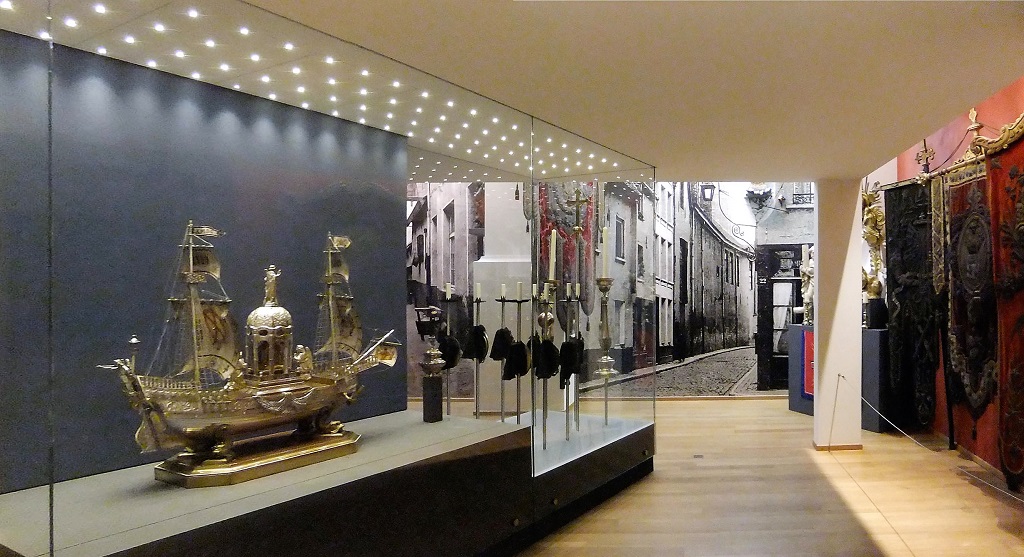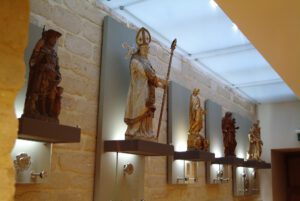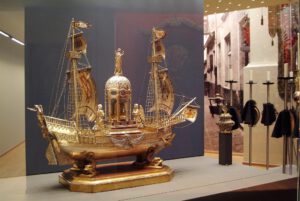Antwerp's St Andrew's Church, a revelation.
The treasury
In 2006 a new museological space was furnished on the ground floor of the new storage depot. This is not only conceived as a classical treasury but shows the story of religious life in the church, the neighbourhood and at home. Now what used to be seen only once a year is on show permanently. SaintThis is a title that the Church bestows on a deceased person who has lived a particularly righteous and faithful life. In the Roman Catholic and Orthodox Church, saints may be venerated (not worshipped). Several saints are also martyrs. Andrew’s district is traditionally called the ‘Parish of Misery’. When one sees the ‘stilled procession’ one would not say that this was far from the richest parish in the city.
‘How much do people value faith?’
The panel Christ in the house of Simon the Pharisee (Antwerp School, 17th century) shows the indignation over so much luxury in the church, while there was (and is) also a great deal of poverty. The onlookers – among whom Judas, who will yield to the power of money and betray Jesus – criticize that a woman, Mary (‘Magdalen’), squanders valuable oil to anoint Jesus’s feet, which she dries with her hair as a sign of honour. “But Jesus said, ‘Leave her alone. Let her keep this for the day of my burial. You always have the poor with you, but you do not always have me.’” (John 12:8)
Apparently, people can spare more money for their religious life in harder times than when they prosper – as can be concluded from the donations in the collection plates. In them there are coins from successive centuries and also a few more recent banknotes. The poorer parishioner contributed his mite, the richer one gave stones – precious ones: diamonds that could be set into valuable liturgical vessels, such as the gilded silver sun monstranceA decorated glass holder on a base, in which a consecrated host can be placed for worship. In general, there are two types of monstrances: the ray monstrance and the tower monstrance, with the name referring to the shape of the object. The tower monstrance is very similar to the reliquary, which was very popular before the adoration of the Blessed Sacrament became widespread. (Wierick III Somers, after a design by Michiel I Van der Voort, 1713-1714). It dates from after 1712, when thieves found nothing better than using the bones that had been piled up against the church wall in the graveyard, as steps, intruding through a stained-glass window and stealing away with the (former) monstrance. A lot of precious metal that had been donated was remelted into specific liturgical vessels, such as the late Baroque chaliceGilded metal cup, usually on a base, which the priest uses for the wine during the Eucharist. (Jan Verschuylen, mid-19th century) and the Baroque silver, partly gilded ciboriumA covered vessel in the shape of a cup that is used to keep consecrated hosts in the tabernacle and to distribute them at communion. (Filip Moermans, Antwerp, 1640-1660). Jewels were also integrally fitted as a decoration to a Mary’s crown (of the procession statue), to a monstrance or to a reliquaryContainer for relics. Often this is a philatory: a decorated glass holder on a pedestal, in which a relic can be placed for veneration. It is important to know that relics cannot be worshipped, only venerated., such as the silver reliquary cross (Antwerp, 1530-1540).
The liturgical vessels
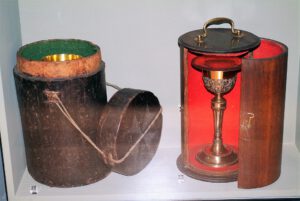
What does one need for massThe liturgical celebration in which the Eucharist is central. It consists of two main parts: the Liturgy of the Word and the Liturgy of the Eucharist. The main parts of the Liturgy of the Word are the prayers for mercy, the Bible readings, and the homily. The Liturgy of the Eucharist begins with the offertory, whereby bread and wine are placed on the altar. This is followed by the Eucharistic Prayer, during which the praise of God is sung, and the consecration takes place. Fixed elements are also the praying of the Our Father and a wish for peace, and so one can symbolically sit down at the table with Jesus during Communion. Mass ends with a mission (the Latin missa, from which ‘Mass’ has been derived): the instruction to go out into the world in the same spirit.? A chalice, a patenSmall, gilded metal plate on which the host used by the priest during the Eucharist is placed. and a chalice spoon, ampullas for wine and water on an ampulla dish, a thuribleA liturgical object consisting of a bowl suspended from three chains. On the bowl is a lid that is also hanging on a chain. In the bowl, grains of incense are placed on glowing coals, so that they begin to smell. By swinging the censer, the fire is stirred up and the incense fragrance can spread further. The censer is used to honour certain people (the priest, the bishop, the faithful, etc.) or certain objects (a cross, the Bible, the Blessed Sacrament, etc.). and an incense boat. The liturgical vessels in this display case mostly date back to the last decade of the 18th century and are partly of gilded silver. In order to protect the valuable vessels each object is secured in a separate box, which was originally made of leather, such as the one for the Abraham Lissau chalice (1634), or of wood.
Veneration of saints
In primitive circumstances saints often act as a guarantee that specific needs will be met. In a corridor there are a number of saints as a sample of all saintsFeast-day on which the Church commemorates all the saints who do not have a feast-day of their own. It is celebrated on November 1st.. Also here they have been arranged suggestively:
- ‘elevated’ on a plinth high against the wall: the statue of the saint who ‘already earned his heaven’, to whom we look up;
- at eye-level: biographies so as to learn to know the saint ‘of flesh and blood’, litanies to pray to him or her, and reliquaries. Tangible relics can mediate to make the deceased saint in heaven, present again on earth, or in other words: to establish contact.
Those who are canonized, are ‘raised to the honour of the altar’. Patron saint Andrew used to receive the place of honour on the high altarThe altar is the central piece of furniture used in the Eucharist. Originally, an altar used to be a sacrificial table. This fits in with the theological view that Jesus sacrificed himself, through his death on the cross, to redeem mankind, as symbolically depicted in the painting “The Adoration of the Lamb” by the Van Eyck brothers. In modern times the altar is often described as “the table of the Lord”. Here the altar refers to the table at which Jesus and his disciples were seated at the institution of the Eucharist during the Last Supper. Just as Jesus and his disciples did then, the priest and the faithful gather around this table with bread and wine.; hence the modello by Otto van Veen: The martyrdom of Saint Andrew. Others had a sculpture against a pillar, such as Saint Cornelius, who was invoked against, convulsions among other things.
In order to support the devotion at their own altar the chapel’s masters of Saint Anne went round with a special polychrome, wooden collection plate with an incentive at the back: “PUT YOUR CHARITY INTO THIS SO AS TO MAKE SAINT ANNE’S ALTAR ANNO 1673”. The relief also shows saints who received an honourable position on the altar, such as Sebastian, Anthony AbbotThe man who has been chosen by the abbey community of which he is a member to lead that community for a fixed period. and Mary Magdalen.
The relics could be venerated in a figurative reliquary that was presented to the believer so that it could be touched, such as with the relics of Our Lady and of Saint Severus. On special feasts the relics were also shown on the altar, more specifically in the plinth of the saint’s bust, such as was the case with Saint Anthony Abbot and Saint John of Nepomuk. Sometimes the plinth of such Baroque reliquaries has been worked as a kind of miniature altar tomb, such as with Saint Roch. It is touching how the statue of Saint Roch as a pilgrim was dressed with a real little cloak.
Someone who has received something and is polite, says ‘thank you’. In the devotion for saints this can be seen in ex-votos. This literally means ‘from a promise’. It are signs of gratitude, no matter whether these are expensive half-reliefs in (sometimes silvered) metal, or cheaper wax puppets.
These ex-votos reflect four basic values. First of all: physical health with nearly all the parts of the human body. Next, human relationships in the family: husband and wife, entwined hands of conjugal fidelity, babies and adolescents. Then there is livestock and home. The most remarkable ex-voto is a silver-plated cannonball, from parishioner and first Belgian Antwerp mayor Gérard Legrelle to Our Lady of Support and Victory. It is a grateful reminder of the Dutch bombing of Antwerp on 27th October 1830, when over six hundred houses were destroyed but only about a hundred civilian casualties were lost.
To continue the veneration of saints one could take a print of a saint home. In a woodcut of the Brotherhood of the Holy Guardian Angels an angel takes a young man in protection. In the background figure Our Lady’s spire and the then tower of Saint Andrew’s.
The procession goes out
The annual processions were the link between church and quarter. The ‘common men (and women)’ took part in them without hardly any exception, even though since the 19th century they had already somewhat dissociated from the Church.
The disposition in the showcase is a faithful representation of the procession, be it that the length has been abridged from 120 metres to 7 metres. It is opened by ‘the sign of the cross’: the processional cross. This is followed by the brotherhoods, each with their own banners, ceremonial staffs, saint’s statues and lantern badges. Because of their size the colourful procession banners have been pushed close to each other at the side, but so they immediately evoke the dynamism of the festive parade. The brotherhoods walk in hierarchic order: first those with a saint, such as Cornelius, then the 36 saints and next Andrew, the patron saint. Behind them the chapel’s guardians carry Mary as the ‘queen of saints’. Finally there is Christ, present in the Holy SacramentIn Christianity, this is a sacred act in which God comes to man. Sacraments mark important moments in human life. In the Catholic Church, there are seven sacraments: baptism, confession, Eucharist, confirmation, anointing of the sick, marriage and ordination..
The reliquary of the 36 Saints (Jan Verschuylen, 1845)
This showpiece was not only carried in the procession through the streets of the parish by a team of 16 men, it was also put on show on a sumptuous plinth in the middle of the church during its octave. The reliquary, which is in the back of the church, is represented here by a miniature version crowning the ceremonial staff of the brotherhood.
The ‘little ship of Amalfi’ (Jos Junes, 1929)
The silver phantasy ship was made at the occasion of the 400th anniversary of the parish, when the church still had the wind in its sails. The name was borrowed from the city where Andrew’s body is said to be resting. The patron saint is on top of a scale model of the church tower and, referring to his vocation story, as a ‘fisher of men’ also in his parish Andrew gathers all kinds of fish in his nets.
The statue of Mary
The eye-catcher of the procession is the crowned statue of Mary, cloaked in a mantle of state. Mary’s statue itself is in the church as a subject of devotion. Here we only evoke the impression the statue made in the procession. On special Marian feasts, such as Our Lady’s Assumption (15th August) and during the octave of Our Lady of Support and Victory in November, the statue was taken from its altar, adorned and put on a decorated plinth. Then she received a long procession mantle with a train and her outfit was brightened up with a slipknot around her arm in the same colour as the cloak, a lace ruff and a silver key and bunch of grapes. Until the mid-1960s the statue was carried through the parish in the procession on the 15th August.
At the occasion of the 1838 jubilee mayor and parishioner Gérard Le Grelle had a big and small silver apron made by silversmith Jan Verschuylen, in grateful remembrance of the Belgian independence victory in 1830-1832. The Belgian lion with banners that decorates the apron symbolizes regained freedom. Because Mary shares her Son’s heavenly glory, she too may wear a royal crown and carry a sceptre. Since 1844 Mother and Child have been wearing new crown jewels on the grand feasts of August 15th and the November octave. They contain 1099 little diamonds and 24 coloured stones from various donations. These were incorporated by silversmiths Jos De Haes and PetrusHe was one of the twelve apostles. He was a fisherman who, together with his brother Andrew, was called by Jesus to follow Him. He is the disciple most often mentioned In the Gospels and the Acts of the Apostles. His original name was Simon. He got his nickname Peter (i.e. rock) from Jesus, who, according to tradition, said that He would build His Church on this rock. Coetermans.
For the next jubilee, in 1863, the Remigius Orban workshop manufactured a mantle of state of red velvet silk, hemmed with ermine. The designer was Edward Dujardin, the first illustrator of the novels by Hendrik Conscience. In the big processions this mantle added splendour to the statue of Our Lady, who was carried through the parish as a queen. It is hard to imagine something more majestic.
Amid a rich decorative pattern in relief gold embroidery there are ten medallions in flat embroidery, each with a flower that is a symbol of a Marian virtue. The iconography is related to the contemplative order of the Annonciades, which is also called ‘The order of Mary’s Ten Virtues’. It was founded in 1500 by Jeanne de Valois, the repudiated wife of the French king. These are the flowers and the virtues they represent, according to the caption:
- snow-white lily: immaculate virginal purity
- heavenly blue hyacinth: wise caution
- green palm: lively faith
- humble violet: deep modesty
- flaming tulip: fiery love
- purple rose: steadfast patience
- docile sunflower: diligent obedience
- red pomegranate flower: deliberate poverty
- multi-coloured passion flower: compassionate sadness
- the imperial crown: continuous piety
This floral symbolism was imitated by the neighbours: already one year later (1567) the statue of Our Lady of the Castle in Saint George’s church received a mantle of state with ten flower medallions, while Saint Fredegandus church in Deurne has had a simple version since 1876. In 1993-1994 the silver embroidering of the cloak was freshened up by ladies of the British heritage society ADFAS, using – do not be surprised – natural enzymes of human saliva.
In 1863 the statue also received a few ornaments: a silver rosary with a gilded cross and a gilded heart, a golden cross, earrings, a broche and a silver bouquet. Until far in the 20th century civilians regularly donated jewels so as to show their affection to Our Lady.
The last in hierarchy is Jesus Christ. He is present in the Holy Sacrament that is shown in the monstrance, carried respectfully by the vicarAccording to Canon Law, a vicar is a substitute of a minister. In a diocese, several vicars assist a bishop: priests who look after a certain policy area within the diocese (parishes, liturgy, etc.)., who is wearing a golden cope and humeral veilHeadgear worn by female religious. Until the Second Vatican Council, all nuns wore wimples, which covered the entire hair and neck. Nowadays, the veil is usually worn on the hair.. The canopy is surrounded by six procession lanterns, referring to the same number of altar candle holders in the church.
This procession ends at a wayside altar that has been reconstructed with the appropriate statues against a gigantic wall-size photo of the spot where it was originally put up: the corner of Korte Ridderstraat and Steenhouwersvest, with Saint Andrew’s tower in the background.
The once so numerous Our Lady’s statues got supplementary decoration when the procession passed by. This is why an old and large statue of Mary, which used to be part of a demolished house, has been adorned and put up against the photo of Korte Ridderstraat, showing a (real) corner statue of Mary that was embellished for the occasion with a silver crown, sceptre and rosary, as was the custom then. The church owns a dozen ensembles of silver decoration pieces for statues, which used to be the property of the numerous neighbourhood societies.
In the parish lived middle class but also a great number of poor people, who had their slum houses in the very many narrow alleys. On the next wall-size photo (as large as the other one), hidden behind a buttress, the statue of Mary is concealed by ma’s (or grandma’s) laundry. Next to the photo there is an authentic simple Our Lady’s little chapel
A small church that is not a parish church. It may be part of a larger entity such as a hospital, school, or an alms-house, or it may stand alone.
An enclosed part of a church with its own altar.
with a wooden puppet and decorated with paper flowers. Opposite there is a statue of Saint Roch, who was invoked against lethal cholera especially in the middle of the 19th century.
The feast of Our Lady of Support and Victory
Besides the feast of Antwerp’s patron on August 15th, there was the feast of Our Lady of Support and Victory with an octave in November. But “in order not to have this celebration in the cold winter months” in the 1950’s this feast was moved to that of Our Lady of the Rosary in October, a celebration that is connected with the victory over the Ottomans, alias ‘the Turks’.
Part of the usual feast goods are banners, ribbons and festoons, plates with chronograms and mottos, songs and music performances. At the first 25th anniversary, in 1714, the title ‘Victory’ was represented in a really military way. Not only were Turkish costumes used, including caps and feathers, but also trees and Turkish carpets were supplied for the scenery, and real weapons of the Spanish troops in the citadel were borrowed, with gunpowder as well. Everything was less playful and thunderous in 1790: for the first time after Joseph II had forbidden parades, the procession of Our Lady of Support and Victory went out again, accompanied by armed patriots.
In the 19th century the feast grew into a spectacular manifestation, for which no expense or effort was spared. The statue was positioned in the middle of the church under a gigantic canopy, surrounded by pennants hanging down from the ceiling. It was bathed in a sea of flowers and candlelight. The whole population was mobilized to offer candles and many streets had a neighbourhood society that attended mass on a fixed day of the octave of Our Lady’s Birth (September 8th a.f.). Against the wall there are the simple painted shields with on them the names of the neighbourhood societies in random order, regardless of their financial situation.
Inspired by the Marian devotion in the parish church a number of Our Lady’s statues in the streets of Saint Andrew’s parish have received the title Our Lady of Support and Victory since the 18th century.
Religious life at home
Finally in a few corners we can see a glimpse of religious life in people’s homes. Thus the gilt silver ciborium (Wierick III Somers, Antwerp, 1712) was carried in the Solemn Last SacramentsThese sacraments are administered to someone who is in danger of dying through old age or illness. In this order, they are last confession, anointing of the sick and last communion. Procession that had been held every fortnight since 1676. A lithography by Alfred Ost shows this procession. Next to it there is the silver chrismatorium (Antwerp, 1619-1620)
One of the neighbourhood society books that found shelter in the parish church is this of Our Lady’s statue in Sleutelstraat. Typical devotional objects (end 19th century – mid 20th century) include the crucifix, the statues of Mary and other saints, the rosary, prayer books, holy cards, a holy-water fontA small basin at the entrance of a church, containing holy water so that the faithful may sprinkle themselves with it when entering the church, while making the sign of the cross, as a symbol of outward and inward cleansing., pilgrimage souvenirs, a service card, a brotherhood booklet, medals… Very remarkable also is a cockade of Mary and a paper knife with an image of Mary. The ivory Our Lady of Lourdes reminds us of the famous mission festivals, where missionaries offered objects for sale to fund their work.
The pewter liturgical vessels date back from the so-called Secret Times, when the French also closed the churches. Underground priests, such as vicar Van der Hallen, still wanted to celebrate mass, but they used less valuable liturgical vessels so as not to increase danger.
The 17th century pillow lace testifies the home crafts of women who wanted to earn some extra penny. The lead bread tokens (end 18th century) were distributed to the poor at the occasion of a wealthy person’s funeral, hoping that many would come to pray for the deceased one…
The bronze bell from the refectory of the conventComplex of buildings in which members of a religious order live together. They follow the rule of their founder. The oldest monastic orders are the Carthusians, Dominicans, Franciscans, and Augustinians [and their female counterparts]. Note: Benedictines, Premonstratensians, and Cistercians [and their female counterparts] live in abbeys; Jesuits in houses. of the Alexians (Mechelen, 1548) has nothing to do with Saint Andrew’s parish, but is remarkable because of its iconography: mythical Orpheus taming all kinds of animals with his music: a symbol of the appeasing power of music, also of the Alexians, monks who apply themselves to funerals and care of the sick.
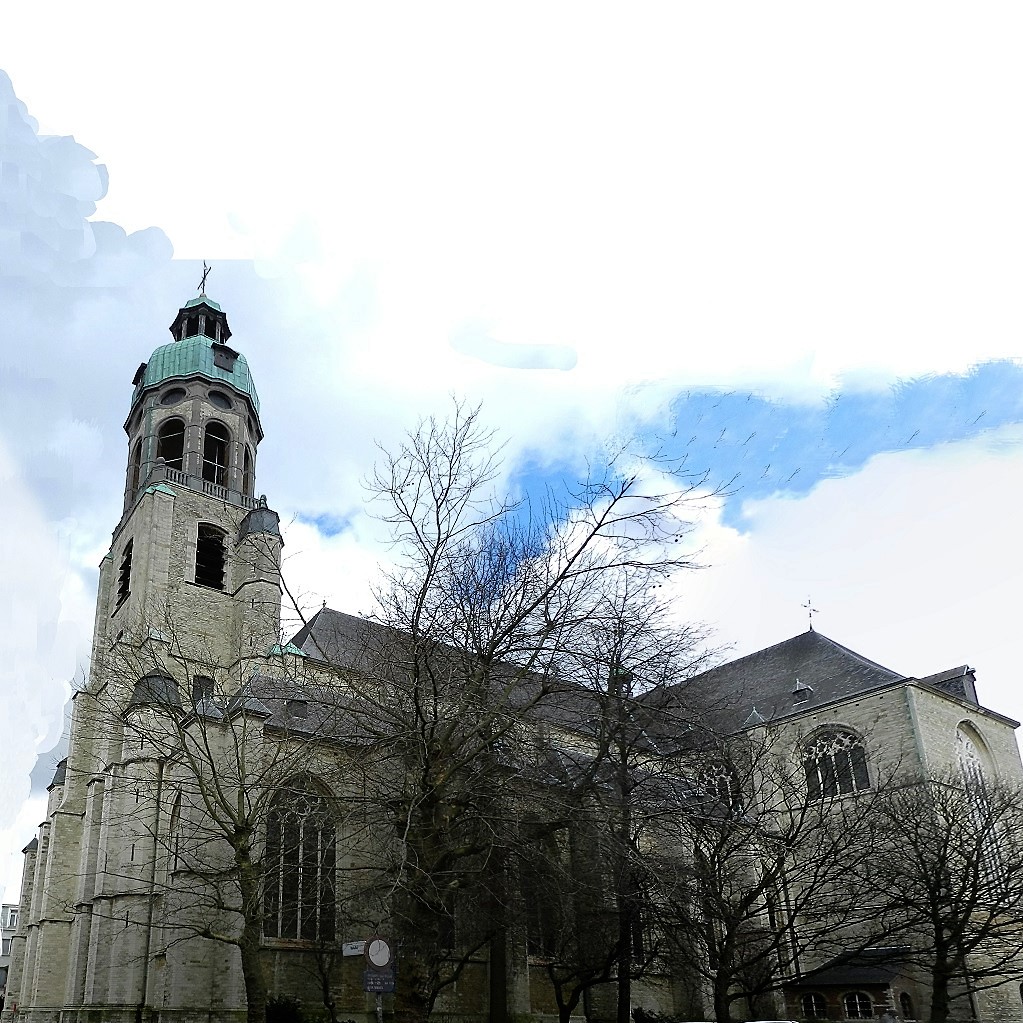
- Saint Andrew’s Church
- History and description
- Introduction
- The historical context
- Building history
- The patron saint
- The outbuildings
- The tower
- Spatial effect
- Saint Andrew’s identity card
- Saint Andrew in Art
- Saint Andrew in ‘his’ church
- The ancient high altar
- The current high altar
- Choir and chancel
- The choir stalls
- The celebration altar
- The Venerable Chapel
- The Mary Chapel
- The Minters’ Altar
- What is Truth?
- Holy Cross Altar
- Saint Anne’s Altar
- The pulpit
- The confessionals
- The organ
- Stained glass – southern aisle
- Stained glass – northern aisle
- The Way of the Cross
- Funeraria
- The treasury
- Bibliography

